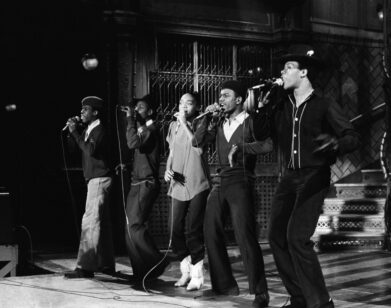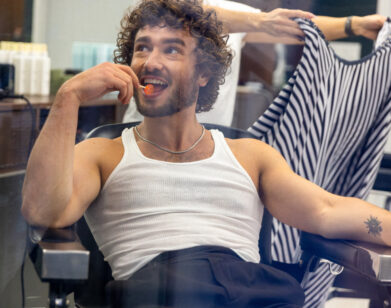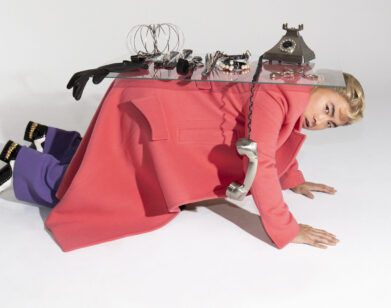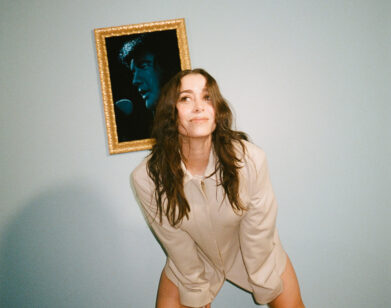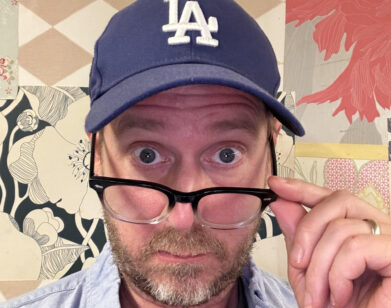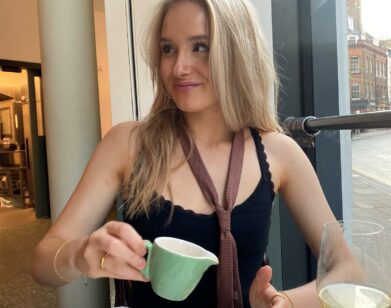Jedi master Mark Hamill geeks out with Bill Hader
From the time of the ancient Greeks, humanity has been fascinated by the struggle between good and evil, often led by an archetypal chosen one who blazes a path of glory by separating himself from the pack. As a young actor toiling between auditions, Mark Hamill’s moment of destiny came when he took a break from TV fare such as General Hospital to read for a role in a little sci-fi film helmed by a young director fresh off an Oscar-nominated hit called American Graffiti (1973). When Hamill was cast in the original 1977 Star Wars as Luke Skywalker, an orphaned farm boy growing up on a desert planet, no one—chief among them Hamill himself—knew that the film would become one of the most influential and profitable franchises ever made.
When the announcement came a few years back that Hamill would reprise his role as the Jedi Knight in J.J. Abrams’s Star Wars: The Force Awakens (2015), along with his original co-stars Harrison Ford and Carrie Fisher, fans went wild. But while Hamill’s screen time was relegated to a small appearance at the end of that film (Skywalker, in ascetic seclusion on a remote planet, is discovered by a young woman who exhibits strong signs of the Force), the second installment of the new trilogy, next month’s The Last Jedi, is squarely focused on Skywalker’s journey.
On a late September afternoon, the comedian, actor, and Saturday Night Live alum Bill Hader (who was a vocal consultant for the droid BB-8 in The Force Awakens) called up Hamill from the Sony lot in Los Angeles to geek out about that iconic galaxy far, far away.
MARK HAMILL: Hi, Bill!
BILL HADER: Hey, man!
HAMILL: I’m a big fan of yours. My kids tell me that you came to my house before you were on SNL.
HADER: Yes! I was a PA on Empire of Dreams, the documentary about the Star Wars movies, and I came over to pick up some pictures of you. I sat in your living room, and I believe it was your wife who brought down the pictures, and I was like, “Oh my god, Mark Hamill’s so rad.”
HAMILL: Was I not there?
HADER: You weren’t. I didn’t want to touch anything, and the whole time I kept apologizing for my existence.
HAMILL: Were any of my kids there? Nathan or Griffin or Chelsea?
HADER: No, but when I first moved to L.A. in 1999, Nathan and I ran in the same circle for a bit. I had a friend who had a massive crush on him. I remember once we had to go to this bowling thing because Nathan was going to be there. [sirens wail in the background] Sorry, I’m robbing a bank right now. Hold on.
HAMILL: [laughs] I saw your tauntaun and Jabba the Hutt impersonations on YouTube. It’s a talent of yours I had never seen. I like that you keep alive the legacy of some of the actors that I love, like Vincent Price. I’ll be talking to people your age and younger, and I’ll mention Lee Marvin [Hamill’s co-star in The Big Red One, 1980] and a lot of them will go, “Who’s Lee Marvin?”
HADER: Oh, my god.
HAMILL: It just goes to show how fleeting fame is.
HADER: I remember I was at Comic-Con once, and I looked over and there was this long line for, I don’t know, the stars of some lesbian vampire series from Mexico, and then all by himself was [stop-motion animation and special effects master] Ray Harryhausen.
HAMILL: Did you go talk to him?
HADER: Yeah! I was like, “Oh my god, you’re Ray Harryhausen.”
HAMILL: He’s always been an icon for me. I was so into that stuff as a kid. I mean, The 7th Voyage of Sin-bad [1958] and Jason and the Argonauts [1963] and First Men in the Moon [1964] and on and on and on. I lived for that stuff. I got to interview him once on the floor at Comic-Con for Comic Book: The Movie—he was the quintessential gentleman of another era.
HADER: Were you always a fan of this stuff?
HAMILL: I was a total freak for these kinds of movies. As for getting the role of Luke Skywalker, I really stumbled into it. Just last year, I saw that they included our audition tapes as a DVD extra, and I saw William Katt’s and Robby Benson’s and Kurt Russell’s tapes, and they were all great. It seems so arbitrary that I was anointed.
HADER: Was it true that they were casting for Carrie [1976] at the same time?
HAMILL: When we auditioned, it was a total cattle call, where they didn’t even tell us about the movie—we just went in and talked for a few minutes. Brian De Palma was looking for actors for Carrie and sitting next to him was George Lucas. Since Lucas didn’t speak the whole time, I thought he was De Palma’s assistant. I didn’t know what he looked like! So I did my thing, and a couple of weeks later, I went to my agent, and there were six or seven pages of audition material for me. By the time I got the part, I assumed that Harrison Ford was the lead, because he’s a traditional leading man. I thought I was going to be his sidekick, you know, like Captain America and Bucky.
HADER: Or Batman and Robin.
HAMILL: Then I opened up the script, and at the time it said: The Adventures of Luke Starkiller as Taken From the “Journal of the Whills,” Saga I: Star Wars. I just couldn’t believe my eyes. I thought, “How are they going to do all this?” Robots, the Death Star, all of it—it blew my mind.
HADER: Did you have confidence that they could do it?
HAMILL: You have to believe. But it’s always a little disconcerting—what you imagine in your head and what you see on set.
HADER: Describe a moment on set when you went, like, “Wait, these are the Sand People?”
HAMILL: The lightsabers, for a start. George referred to it as the most expensive low-budget movie ever made. At one point, Fox screened raw footage to some people, because they needed more money to finish it. Imagine it with no effects, no music, no nothing. The general consensus, because it played so horribly, was that they should just shut it down and take a tax loss. It was only [20th Century Fox executive] Alan Ladd Jr. who saw the potential and gave us his blessing. I think they gave us like a million and a half more. Do you remember seeing it when you were young? Did it scare you, or did you love it?
HADER: I remember going to see Return of the Jedi [1983] on my fifth birthday—the people tearing the tickets were dressed as stormtroopers—but the first image I can remember on a movie theater screen is that close-up from Empire [The Empire Strikes Back, 1980], of Han in carbonite. I flipped out, and my dad had to take me out of the theater. Then he told me the whole thing on the ride back; he was like, “Darth Vader is Luke Skywalker’s dad!” And that’s how he said it—not his father, his dad. [laughs] What was it like, back then, leading such a massive franchise?
HAMILL: It was kind of like The Prince and the Pauper, where one day you’re nobody and the next you’re partying with Andy Warhol. It was surreal. I came from a big enough family, so I didn’t let it get to my head too much or change my view of the world. The first time I went to the Oscars was like that, too. It wasn’t really me walking the red carpet. It was like watching a movie of a Hollywood premiere. You have to have an intellectual distance from it, because it’s so atypical from your everyday life. I’m sure you feel the same way. You can’t sit in the park and people watch anymore, that ship has sailed. Star Wars ebbed and flowed, but I never expected it to come back, certainly not with this intensity. Carrie and I were in Orlando, with fans. It’s just astonishing the passion and affection that they have for all of this stuff. It’s overwhelming. You can get emotional about it because it’s so personal, the way they relate it to their own lives.
HADER: Batman, too. [Hamill has served as the voice of the Joker in animated series, films, and video games, starting with Batman: The Animated Series in 1992.]
HAMILL: That’s a whole subgenre of comic book nerds who know that I’m a nerd, too. I’m one of them, so they love the fact that I’m not posing.
HADER: What is it like working with [Last Jedi director] Rian Johnson or J.J. Abrams, people who grew up with Star Wars? Is it ever weird to be told things about your character, when you know him better than anyone else?
HAMILL: With J.J. and with Rian, it’s the first time that the fan generation has grown into being in the position that they are. I was surprised in many ways how they saw not just my character, but the overall piece, because you get really possessive over the years. But Rian, what a blessing that guy is. He is unassuming and amiable. I’ve never seen him raise his voice. I’ve never heard him curse. I never heard him humiliate anybody else in front of the entire crew.
HADER: [laughs] When the first trilogy ended, did you feel a sense of relief? I know when I left SNL, it was a big relief.
HAMILL: It was exhilarating. It felt like senior year of high school. You know those last moments when you’re clearing out your locker? You’re going to miss all these people you know, but there’s the exhilaration of what comes next. It’s like jumping out of an airplane and hoping for the best, hoping your parachute opens. I was lucky that a lot of pressure was taken off financially; I didn’t have to do stuff that I didn’t want to do, so I indulged myself. I always wanted to do theater, so I did lots of theater. I got to do a comic mockumentary, and I wrote a comic book, and I discovered that the Joker gave me a whole new career. I didn’t expect to be the Joker, of course, but with voice acting, it liberates you to play characters you’d never do in a million years because you’re physically not right. You can show up looking like hell, you don’t have to memorize your lines because you can read them right off the page, and you get to play the most fun parts. You come in and you kick everyone’s ass and you get your own ass kicked, and then you go home.
HADER: I do animated things, too, and they’re so much fun. But do you get tired after a session?
HAMILL: Oh, yeah. It’s a real workout. But it’s so entertaining. It’s like going to a really great nightclub act and getting paid for it.
HADER: I really liked The Big Red One. What was that like?
HAMILL: I was a huge Sam Fuller fan. Within five minutes of meeting him, I went, “Holy Christ, I’ve been drafted!” He got up on his feet and he started telling me the story of that film, with the explosions and the rat-a-tat-tat, and I was mesmerized. He had such charisma, such magic. He was a firecracker, like Yosemite Sam. I was traumatized when it came out because, even though it got good reviews and takes its place among the great war films, it wasn’t what we all hoped for. They cut it down to an hour and 50 minutes, to the point where it was so incomprehensible. Now, of course, it’s been restored to its proper length. If anybody’s reading this and is thinking about watching the movie: make sure it’s the two-and-a-half-hour version! Not that truncated version. I wish Sam were alive to have seen that because that would have made him happy, and he deserved it. Like any great artist who is ahead of the time, he was not welcome in Hollywood at a certain point.
HADER: There was a great documentary about him called The Typewriter, the Rifle, & the Movie Camera. That was when I first heard about him.
HAMILL: Was I in it?
HADER: You’re not talking in it, but there’s a clip from The Big Red One in it.
HAMILL: Okay, yeah, I remember that one. I hope you and I get to work together some time.
HADER: That would be awesome.
HAMILL: I have been loyal to Saturday Night Live from the very beginning. When it first came on, I said, “We’d better enjoy this because it’s for sure going to be cancelled. This is only going to last one season.” So I started taping them all. I had no idea it would become such an institution. I guess we can both relate to getting lucky and hitting the jackpot.
BILL HADER IS A COMEDIAN, ACTOR, AND WRITER. THIS SPRING HE WILL STAR IN THE HBO SERIES BARRY, WHICH HE CO-CREATED.


